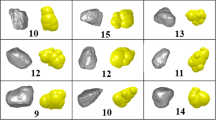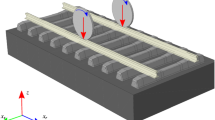Abstract
To explore the relationship between the dynamic model parameters of a stabilizing device coupled system and the quality status of a ballast bed, this study establishes a dynamic model of a frame-stabilizing device-rail sleeper system by combining track coupling dynamics with the operating mechanism of a stabilizing device and by using the lumped parameter method. Moreover, by combining the experimental results and nonlinear least squares identification method based on the trust-region reflective algorithm, the mapping relationship between the model parameters and the lateral resistance of the sleeper is discussed. In addition, the dynamic model is validated by numerical simulation using the fourth-order Runge-Kutta method. Results show that the model has good accuracy, and the acceleration peak error rates between the dynamic model response and the test data are all within 5 %; the lateral resistance of the sleeper is positively and negatively correlated with the transverse stiffness and transverse damping of the ballast bed in the system model, and the correlation coefficients are 0.96 and 0.89, respectively.
Similar content being viewed by others
References
H. El-sayed, M. Fayed, H. Riad and H. Zohny, A review of the structural performance of prestressed monoblock concrete sleepers in ballasted railway tracks, Engineering Failure Analysis, 140 (2022).
J. Pons, I. Sanchis, R. Franco and V. Yepes, Life cycle assessment of a railway tracks substructures: comparison of ballast and ballastless rail tracks, Environmental Impact Assessment Review, 85 (2020) 106444.
K. Prasad and S. Hussaini, Review of different stabilization techniques adapted in ballasted tracks, Construction and Building Materials, 340 (2022).
H. Lam, M. Wong and R. Keefe, Detection of ballast damage by in-situ vibration measurement of sleepers, AIP Conference Proceedings, 1233(1) (2010) 1648.
J. Sadeghi and H. Askarinejad, An investigation into the effects of track structural conditions on railway track geometry deviations, Proceedings of the Institution of Mechanical Engineers, Part F: Journal of Rail and Rapid Transit, 233(4) (2009) 415–425.
B. Mao, Dynamic Track Stabilizer, China Railway Press, Beijing, China (2008).
L. Yang, W. Powrie and J. Priest, Dynamic stress analysis of a ballasted railway track bed during train passage, Journal of Geotechnical and Geoenvironmental Engineering, 135(5) (2009) 680–689.
H. Yao, Z. Hu, Z. Lu and H. Wang, Analytical model to predict dynamic responses of railway subgrade due to high-speed trains considering wheel-track interaction, International Journal of Geomechanics, 16(2) (2016) 737–756.
B. Park, Y. Choi and S. Hwang, Ballasted track status evaluation based on apparent track stiffness index, Applied Sciences, 10(14) (2020) 4729.
D.-S. Kim, S.-S. Kwon, S.-H. Lee, S.-K. Hwang and T.-S. Park, Study on the appropriateness of track maintenance works through the evaluation of trackbed conditions, Journal of the Korean Society for Railway, 11(3) (2008) 334–341.
C. Chen, H. Wang, H. Qin and W. Xiong, On-line detection of vehicle-mounted ballast bed quality status based on improved Kalman filter, Sixth International Conference on Electromechanical Control Technology and Transportation (ICECTT 2021) (2022).
B. Yan and J. Yang, Modeling and parameter optimization of dynamic characteristic variables of ballast bed during operation for dynamic track stabilizer, Complexity, 2021 (2021).
Y. Sarikavak and K. Goda, Dynamic wheel/rail interactions for high-speed trains on a ballasted track, Journal of Mechanical Science and Technology, 36(2) (2022) 689–698.
W. Zhai, Vehicle-Track Coupled Dynamics, Springer, Singapore, China (2020).
M. Malago, E. Mucchi and G. Dalpiaz, Fault detection in heavy duty wheels by advanced vibration processing techniques and lumped parameter modeling, Mechanical Systems and Signal Processing, 70–71 (2016) 141–160.
D. Ahlbeck, The development of analytical models for railroad track dynamics, Railroad Track Mechanics and Technology, Elsevier Inc. (1978) 239–263.
H.-F. Lam, S. Alabi and J. Yang, Identification of rail-sleeper-ballast system through time-domain markov chain monte carlo-based bayesian approach, Engineering Structures, 140 (2017) 421–436.
J. Chen, J. Zhou, D. Gong, W. Sun, Y. Sun, T. You and Y. Ji, Identification of excitation force for under-chassis equipment of railway vehicles in frequency domain, Journal of Vibration Engineering and Technologies, 9(4) (2020) 701–714.
M. Ahsan and M. Choudhry, System identification of an airship using trust region reflective least squares algorithm, International Journal of Control, Automation and Systems, 15(3) (2017) 1384–1393.
B. Yan, Y. Huang, B. Hu and X. Wang, Mechanical characteristics optimization of ballast bed variable on operating process for the dynamic track stabilizer, 2017 9th International Conference on Modelling, Identification and Control (ICMIC 2017), Kunming, Yunnan, China (2017).
L. Wu, Z. Chen, C. Long, S. Cheng, P. Lin, Y. Chen and H. Chen, Parameter extraction of photovoltaic models from measured I-V characteristics curves using a hybrid trust-region reflective algorithm, Applied Energy, 232 (2018) 36–53.
H. Liu, P. Maghoul, A. Shalaby, A. Bahari and F. Moradi, Integrated approach for the MASW dispersion analysis using the spectral element technique and trust region reflective method, Computers and Geotechnics, 125 (2020).
Acknowledgments
This work was supported by the Natural Science Foundation of Sichuan Province (No. 2022NSFSC0395), the Natural Science Foundation of Sichuan Province (No. 2022NSFSC1991), and the Fundamental Research Funds for the Central Universities (No. 2682022CX011).
Author information
Authors and Affiliations
Corresponding author
Additional information
Chunjun Chen received the Ph.D. degree from Southwest Jiaotong University in 2006 and the M.A. degree from University of Electronic Science and Technology of China in 1993. He is a Professor of School of Mechanical Engineering, Southwest Jiaotong University, Director of Department of Measurement and Control and Mechano-electronic Measurement and Control Laboratorial Center and Deputy Director of the Technology and Equipment of Rail Transit Operation and Maintenance Key Laboratory of Sichuan Province. His research interests include vibration, noise and aerodynamics of high-speed trains, traffic equipment, electromechanical systems, advanced control and measurement theory, electromechanical control and measurement system.
Huijie Qin is currently a master’s candidate in School of Mechanical Engineering at Southwest Jiaotong University. His research interests are intelligent sensing, diagnosis and control of rail transportation operation and maintenance equipment.
Meng Lin is a doctoral candidate at Southwest Jiaotong University in Chengdu, China. He received his M.S. from Southwestern Petroleum University in Chengdu, China. His research interests include vehicle system dynamics, mechanical system dynamics and advanced control strategy.
Ji Deng received the B.E. degree in School of Instrument Science and Opto electronics Engineering from Hefei University of Technology, Hefei, China, in 2014, and the Ph.D. degree in School of Precision Instrument and Opto Electronics Engineering from Tianjin University, Tianjin, China, in 2021. He is currently an Assistant Professor with the School of Mechanical Engineering, Southwest Jiaotong University, Chengdu, China. His research interests include rail transit smart operation & maintenance, 3D sensing and related applications.
Rights and permissions
About this article
Cite this article
Chen, C., Qin, H., Lin, M. et al. Dynamic modeling and parameter identification of a track stabilizing device coupled system. J Mech Sci Technol 37, 1685–1697 (2023). https://doi.org/10.1007/s12206-023-0310-3
Received:
Revised:
Accepted:
Published:
Issue Date:
DOI: https://doi.org/10.1007/s12206-023-0310-3




